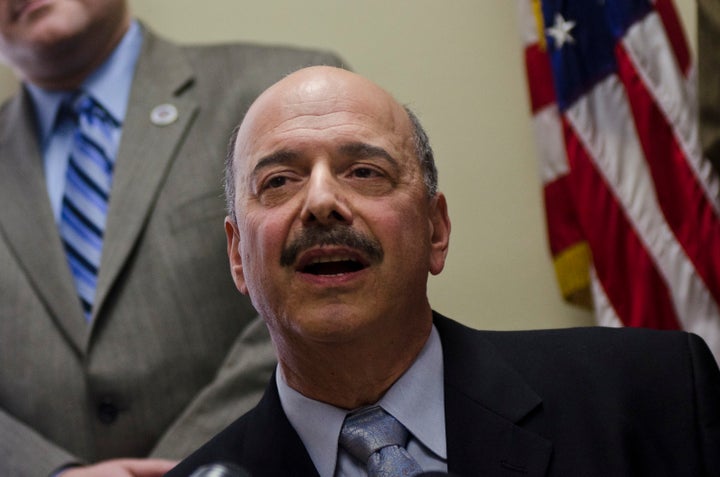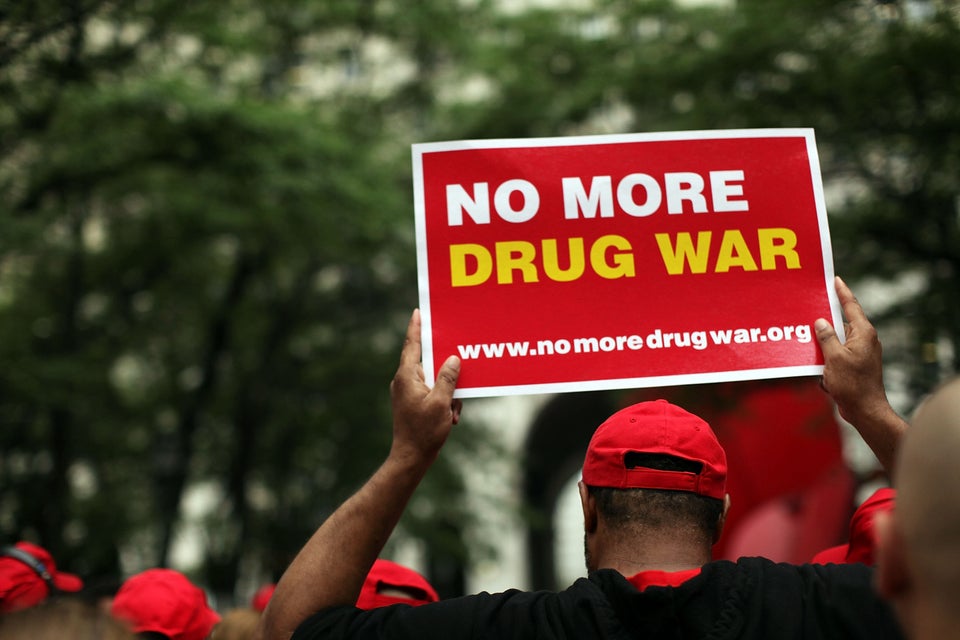
The war on drugs has failed. Slap that assertion into Google and you'll find it in quotes being tossed out by politicians of every stripe, from the highest levels of the Obama administration to the lowest-polling GOP candidate for president.
But if the war has failed, what will peacetime look like?
Dr. Dan Morhaim, who represents part of Baltimore County in the Maryland House of Delegates, wants to start that conversation after decades of treating the fallout from addiction in emergency rooms in Baltimore. On Friday, he'll announce the introduction of a sweeping set of bills that would upend the approach to the opioid epidemic, Morhaim, a Democrat, told HuffPost.
The approach is a radical one likely to scare off nearly all politicians and probably a majority of voters. So let's back into his bills slowly.
Who is Dan Morhaim?
This is not a graduate student coming to the issue with a fresh, theoretical perspective. Morhaim is on the faculty of Johns Hopkins Bloomberg School of Public Health, one of the premier public health universities in the United States, and the University of Maryland Medical School. He's an emergency room physician at both Sinai Hospital and Northwest Hospital in Baltimore. For more than a decade, he chaired the Department of Emergency Medicine at Franklin Square Hospital, throughout the turbulent 1980s and early-'90s. He was part of the Maryland-Kuwait Health Care Task Force that visited Saudi Arabia and Kuwait during the first Gulf War in 1991.
Morhaim's policy approach is guided by his fieldwork. "I've been a doctor for over 35 years," he said. "People don't know that I'm an elected person, I'm just a doc. I'll be sewing a laceration or doing one thing or another and I just talk to people, say, 'Tell me how you got involved with drugs. Have you been to jail? What kind of crimes do you commit? How do you get the money?'"
Morhaim is not a rogue doctor. The University of Maryland School of Medicine, through the department of psychiatry’s division of alcohol and drug abuse, is endorsing his legislation, according to a statement provided to HuffPost by the chair of the department, Bankole A. Johnson, who has so many credentials that 41 letters appear after his name.
How addiction can spread
It’s useful to know something about how people become addicted to heroin in the first place. While the epidemic began with the proliferation of prescription painkillers and an influx of cheap heroin, an individual with an opioid-use disorder has to find a way to keep using. In interviews with current and recovering addicts, one method consistently emerged, namely, the ability of an addict to serve as a sort of middle man between a dealer and another potential user. After an addict has developed a connection to a dealer, they will find customers, encourage them to use, and profit off the deals themselves.
“There’s people who call me all the time who want drugs,” explained J.R., an addict in Louisville, Kentucky. “I might take them somewhere, get drugs for them, and I get a cut off of it.” He said this accounts for maybe 25 percent of the way he is able to keep using heroin.
Morhaim said he regularly hears the same thing from those he treats. "That's a very real factor," he said. "I refer to that many times in presentations. I call it the pyramid scheme of addiction -- between the psychosocial pressures of living in a very difficult society and the desire we all have to change our consciousness to escape some of the stresses, and then you've got your friend trying to hook you to make their marginal money."
This is in part how the disease of heroin addiction can be transmitted from one person to another. In order to slow it down, Morhaim's legislation aims to quarantine Patient Zero. There are two ways to do that, and Morhaim wants to do both.
OK, ready to hear the idea?
The first option is to treat the addiction so that the person is no longer using heroin. For that, a variety of treatments need to be offered, depending on the user and the circumstances. The second option is to treat the social problem by giving the most difficult-to-treat addicts free heroin -- or something very close to it -- in a safe, controlled environment.
The policy proposals were thought through during a meeting of public health professionals, law enforcement representatives and other stakeholders in Baltimore in October. According to notes from the session obtained from a source other than Morhaim, the group recommended heroin-assisted treatment as one option, but noted that the legal hurdles to obtaining heroin were significant. As an alternative, the working group suggested a heroin-like drug could be used, as addicts generally can't tell the difference in double-blind tests.
Morhaim decided to go with what's called poly-morphone-assisted treatment, meaning users would get an injection of a drug similar to heroin. As jarring as it sounds, it's not a new idea. "Poly-Morphone-Assisted Treatment and Safe Injection Facility Programs are interventions that have been used in various European countries, as well as Canada, and are currently being considered in several other states, including New York and California," writes Dr. Johnson in the letter of support from the UM School of Medicine. These programs have been demonstrated to reduce opioid overdoses, decrease transmission of HIV and Hepatitis B and C, and reduce other injection-related illnesses, such as endocarditis and abscesses."
There are, of course, risks. A study published in The New England Journal of Medicine found that such treatment significantly outperformed traditional methadone when it came to retaining people in the program. But among those enrolled in the treatment, there were adverse complications, such as overdoses and seizures. The study recommended such treatment “should be delivered in settings where prompt medical intervention is available,” a condition Morhaim requires in his legislation.
Dr. Yngvild Olsen, an addiction medicine physician based in Baltimore who has written on the U.S. treatment system, isn’t convinced that poly-morphone-assisted treatment is necessary, given how underutilized even established treatments are. “We have not really fully taken advantage of treatments that include methadone or buprenorphine,” she said.
Olsen also said she doesn’t think such treatments or safe-injection sites would have a big impact on the Baltimore drug economy. The issues fueling the trade -- a lack of real jobs, good schools and other social supports -- are too complex and entrenched.
Morhaim, though, doesn't see his proposal as a panacea, but as a last resort only for people who've been through every sort of treatment. And he doesn't want to wait until the rest of society's ills are solved to begin dealing with the heroin problem. The way Morhaim sees it, even if only a few thousands addicts are removed from the illegal drug economy, it can have a big impact.
The $350 million solution
There are roughly 19,000 hardcore addicts in Baltimore, Morhaim said. (The Baltimore Department of Health puts the number of addicts significantly higher, but Morhaim only counts the most heavily addicted.) For some uncertain percentage of those with severe opioid-use disorder, no amount of traditional treatment is going to get them on the path to recovery. Society can either ignore that and push forward with a policy that doesn't work for all who suffer with this addiction, or it can deal with the fact. And Morhaim wants to deal with it.
"There is no one-size-fits-all. Some will do well with faith-based, 12-step, methadone, suboxone, threat of jail, etc. And some won't," Morhaim said. "And some will need several trials before there is a degree of success. Each addict has a different history and resources. I hope addicts will avail themselves of the current methadone and suboxone programs and any and all others that might work for them. ... [F]or those for whom the other programs are not working, poly-morphone may be an option."
The drain that 19,000 opioid addicts can have on a local economy can be daunting. If you assume conservatively that an addict spends $50 a day feeding the habit, that adds up to $950,000 per day among the hardcore addicted population, and almost $347 million in a year. And that's just Baltimore.
That's big money, and it's money the addicts do not have lying around, yet they manage to come up with it. And the way they come up with it is deeply destabilizing to the community -- copper pipes are ripped out, jewelry disappears, other users are roped in, and on and on. If only 1,000 users entered the poly-morphone-assisted treatment program and took themselves out of the illegal drug economy, that's roughly $18 million they wouldn't have to come up with over the course of a year. For Morhaim, that's reason enough to move in a different direction. "This is a harm-reduction strategy for the rest of society," he said.
Beyond the most far-reaching piece of legislation, Morhaim is also proposing measures more likely to be approved in the short term. One would require on-demand addiction counseling 24/7 at hospital emergency rooms. Those suffering with opioid use disorder have sometimes been met with indifference from doctors and nurses. Last year, Kentucky passed a bill that required emergency rooms to offer support services to addicts.
A second bill would create "safe consumption programs" -- places where users could bring their own drugs and find sterile equipment, while also connecting with medical care and other social services. Similar facilities in Europe, Australia and Canada, Morhaim said, have reduced the spread of infectious diseases and eliminated overdoses, because medical staff is immediately available. (The safe spaces would presumably free up restrooms for the general public, too.) And finally, an additional bill would decriminalize possession of small amounts of drugs, making it a civil violation rather than a crime.
The crisis, said Morhaim, has reached the stage where it's time to try something new. "The poly-morphone legislation is a four-year pilot program," he said. "Maybe it will work, maybe it won't. But (in my opinion), it will work, as it has in other countries, but will need course adjustments as it proceeds."
Jason Cherkis contributed reporting.
Sign up here to get an email when Ryan Grim writes a new story.
Also on HuffPost:

